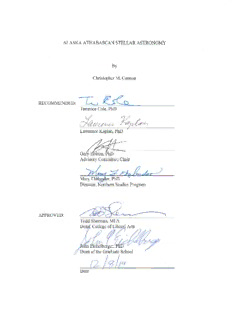
Alaska Athabascan Stellar Astronomy PDF
Preview Alaska Athabascan Stellar Astronomy
ALASKA ATHABASCAN STELLAR ASTRONOMY A THESIS Presented to the Faculty of the University of Alaska Fairbanks in Partial Fulfillment of the Requirements for the Degree of MASTER OF ARTS By Christopher M. Cannon, B.S. Fairbanks, Alaska December 2014 © 2014 Christopher M. Cannon Abstract Stellar astronomy is a fundamental component of Alaska Athabascan cultures that facilitates time-reckoning, navigation, weather forecasting, and cosmology. Evidence from the linguistic record suggests that a group of stars corresponding to the Big Dipper is the only widely attested constellation across the Northern Athabascan languages. However, instruction from expert Athabascan consultants shows that the correlation of these names with the Big Dipper is only partial. In Alaska Gwich’in, Ahtna, and Upper Tanana languages the Big Dipper is identified as one part of a much larger circumpolar humanoid constellation that spans more than 133 degrees across the sky. The Big Dipper is identified as a tail, while the other remaining asterisms within the humanoid constellation are named using other body part terms. The concept of a whole-sky humanoid constellation provides a single unifying system for mapping the night sky, and the reliance on body-part metaphors renders the system highly mnemonic. By recognizing one part of the constellation the stargazer is immediately able to identify the remaining parts based on an existing mental map of the human body. The circumpolar position of a whole-sky constellation yields a highly functional system that facilitates both navigation and time-reckoning in the subarctic. Northern Athabascan astronomy is not only much richer than previously described; it also provides evidence for a completely novel and previously undocumented way of conceptualizing the sky—one that is unique to the subarctic and uniquely adapted to northern cultures. The concept of a large humanoid constellation may be widespread across the entire subarctic and have great antiquity. In addition, the use of cognate body part terms describing asterisms within humanoid constellations is similarly found in Navajo, suggesting a common ancestor from which Northern and Southern Athabascan stellar naming strategies derived. v Table of Contents Page Signature Page …………………………………………………………………………………….i Title Page ………………………………………………………………………………………...iii Abstract …………………………………………………………………………………………...v Table of Contents ………………………..………………………………………………………vii List of Figures ……………………………………………………………………..……………..xi List of Tables ………………………………………………………………..……….…………xiii List of Appendices ……………………………………….……………………………………...xv Acknowledgments …………………………………...…………………..…….………………xvii Chapter 1: Introductory Materials ………………………………………………….…….……….1 1.1. Introduction …………………………………………………………………………..1 1.2 Literature Review ………………………………………………………………….....3 1.2.1 Southern Athabascan Sources …………………………...………………….3 1.2.2 Alaska Athabascan Sources ………………………………………………...5 1.2.3 Canadian Athabascan Sources ……………………………………………...8 1.2.4 Alaska Athabascan Dictionaries ………………………………………........9 1.2.5 Unpublished Materials …………………………………………………….10 1.3 Methodology ……………………………………………………………………..… 13 1.4 The Athabascan Language Family …………………………………………………..16 Chapter 2: The Athabascan Starscape – Whole-Sky Constellations ………………………........23 2.1 Gwich’in Yahdii …………………………………………………………………......24 2.2 Upper Tanana Yihdaa and Neek’e’eltiin ……………………...……………………..31 vii Page 2.3 Ahtna Nek’e Neghaltaexi and Nek’eltaeni ……………….………..……………..….38 2.4 Dena’ina Naq’eltani and Yuq’eltaeni …………………….………….…………........44 2.5 Koyukon Naagheltaale ………………………………………………………..…….47 2.6 Tanacross Neek’e’elteen ………………………………………………………….....51 2.7 Fragmentary Evidence from the Other Alaska Athabascan Languages …………….51 2.8 Chapter Two Conclusion ………………………………………………………........53 Chapter 3: Linguistic Evidence for a Pan-Athabascan Strategy for Mapping the Sky ………….57 3.1 Two Widely Attested Athabascan Forms for the Big Dipper ……………………….57 3.1.1 Category A: Yahdii and Cognates Thereof …….………………………….60 3.1.2 Category B: Big Dipper Terms that Share Common Verb Stems and Prefix Morphemes ……………………………………………………………………...64 3.1.3 Category C: Other Big Dipper Terms ……………………………………..70 3.3 Body Part Asterisms …………………………………………………………….......71 3.4 Chapter Three Conclusion ……………………………………………………….….78 Chapter 4: The Function and Utility of Alaska Athabascan Stellar Astronomy …………….......81 4.1 Stellar Time-Reckoning ……………………………………………………………..81 4.1.1 A Tripartite Stellar Time-Reckoning System ……………………………..83 4.1.2 The Big Dipper and Whole-Sky Constellations in Time-Reckoning ……..84 4.1.3 The Morning Stars in Time-Reckoning …………………………………...92 4.1.4 The Sun in Time-Reckoning ……………………………………………..103 4.2 Stellar Orientation ………………………………………………………………….108 4.2.1 Stellar Orientation: A Basic Strategy …………………………………….114 4.2.3 Stellar Orientation: A Complex Strategy ………………………..……….116 viii Page 4.3 Weather Signs Interpreted from the Stars ………………………………………….121 4.4 Stars in Cosmology and Religion ………………………………………………….128 4.4.1 The Creation or Placement of the Stars ………………………………….129 4.4.2 Taboos, Protocols, and Other Stellar Beliefs …………………………….133 4.4.3 Humanoid Constellations in Athabascan Belief Systems ………………..136 4.5 Chapter Four Conclusion …………………………………………………………..141 Conclusion ………………………………………………………………………….………….143 References …………………………………………………………………………………..….151 Appendices ………………………………………….……………………….………...……….165 ix List of Figures Page Figure 1.1. Map of “Indigenous Peoples and Languages of Alaska” ….....…………………..…18 Figure 1.2. Na-Dene evolutionary tree ………………………………………...………………..20 Figure 2.1. Whole-sky view of the Gwich’in humanoid constellation yahdii …………………..29 Figure 2.2. Whole-sky view of the Upper Tanana (Northway) constellation neek’e’eltiin ……..34 Figure 2.3. Whole-sky view of the Upper Tanana (Tetlin) constellation yihdaa ……………….36 Figure 2.4. Whole-sky view of the Ahtna constellation nek’eltaeni/nek’e nekeghaltaexi ………41 Figure 2.5. Whole-sky view of the Koyukon constellation naagheltaale ………………………49 Figure 3.1. Distribution of Athabascan Ursa Major/Big Dipper terminology …………………..59 Figure 3.2. Distribution of Athabascan body part asterisms/constellations ……………………..73 Figure 4.1. The Ahtna temporal period yikaas ts’e’ cila’ ilts’iitl’ ………………………………87 Figure 4.2. The Gwich’in constellation of three morning stars …………………………………97 Figure 4.3. A trail sign for time based on the sun’s position ………….………………………107 Figure 4.4. Aerial and ground views of the Yukon Flats ……..………………………………..112 Figure 4.5. The Upper Tanana (Tetlin) stellar group san’ di’ehtsąą’ ………………………….119 Figure 4.6. A bright star known generally as the moon’s dog …………………………………125 Figure 4.7. Upper Tanana kinship terminology applied to stars ………………...……………..131 xi
Description: